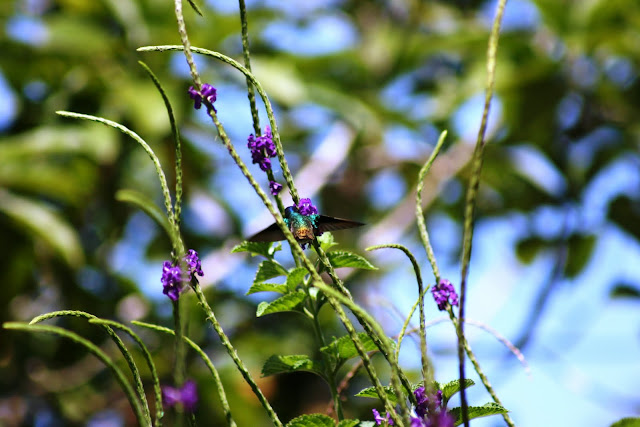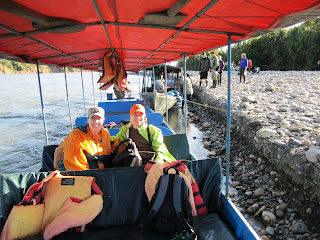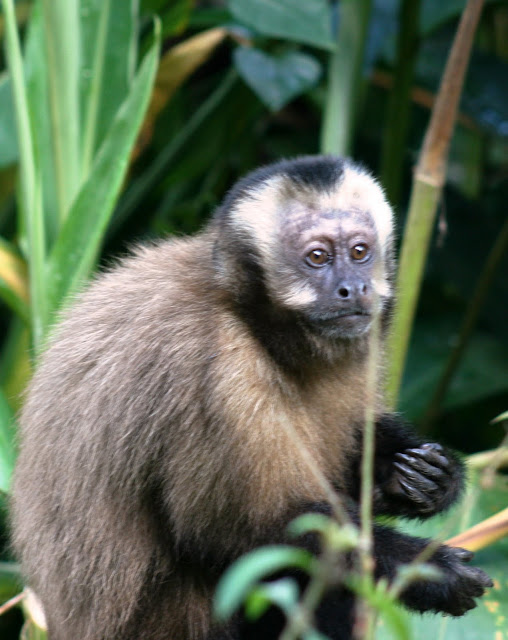It was another boat ride in the dark, then a stumble along the river bank using our flashlights, then we sat in a small shelter on the opposite side of the river to the clay lick and waited. And waited. More tourists arrived and we all waited. As the sky gradually lightened, we could hear the parrots flying overhead – hundreds of them. And we waited. Eventually it was light enough to see large flocks of parrots flying back and forth, and settling in the trees growing on top of the river banks. And we waited. Abraham used the telescope to show us various brightly coloured parrots but they were too far away to take photos. And we waited.
Unfortunately the parrots didn’t come down and settle on the clay cliffs that morning, probably because of the presence of a falcon sitting on top of a tall dead tree. At 7.30, we abandoned our wait and headed back to the lodge. There was one compensation – as luck would have it, during our boat ride Abraham spotted a family of red howler monkeys high up in a tall tree on the river bank so we pulled in to the shore, where we used the telescope to get a closer look at mum, dad and junior snoozing and scratching and checking each other out for ticks.
Breakfast tasted particularly good after our long wait, and we needed the energy boost as, an hour after breakfast, we set off on a 3-hour hike into the hills above the lodge. The Sago de Oro Lodge is located in a transition zone between high and low jungle, so encompasses several different habitats, which explains the high diversity of wildlife found around the lodge. Abraham pointed out particular birds, insects, medicinal plants, and trees, and described the various reptiles and mammals that live in the area. He poked a thin stick down a tarantula hole but the beastie wasn’t home. He showed us the small burrows where armadillos slept at night. He pointed out the tracks of a peccary – a type of wild pig – and, after touching the tracks with his hand, told us the creature had walked along the track at 9.15 that morning. He was a funny guy!
 |
| Abraham doing his Tarzan act |
 |
| Where a tarantula lives |
It was hot and humid and we sweated copiously. Lunch and long cold drinks never tasted better than when we got back to the lodge. That afternoon was for relaxation – a siesta on the bench overlooking the river, an hour spent trying to get a good photo of a humming bird, but the little critters zap about so quickly that it was almost impossible, some time photographing more birds and butterflies, and another hour or so chewing the fat with Abraham and my fellow travellers.
 |
| There's a humming bird in there somewhere |
Late afternoon we went fishing. It was the job of us women to catch the little tiddlers that the men then used to try to catch the much larger catfish. I was useless, Martine caught one, but Marja, the vegetarian who had never fished in her life, caught five or six. It was good fun, and so beautiful on the riverbank as the dusk fell. And we do have a great story of the huge catfish that got away – it pulled the line, and the piece of wood it was attached to, right out of the side of the boat.
We breakfasted while we waited for the birds because at 7am we began the long bumpy ride back to Cusco. I was weary and snoozed on and off. We made good time and got back to the city about 4pm. We had one last stop to make – at Abraham’s office to select our free tshirt. I chose one that has the pictures and names of the animals we weren’t lucky enough to see during our trip – the jaguar, the spectacled beer, the giant otters … I certainly wasn’t disappointed though, as we had seen an incredible variety of wildlife, and I’m already planning another jungle adventure.














































